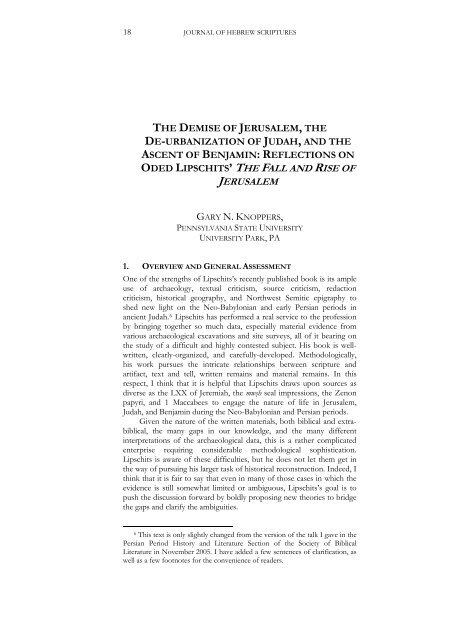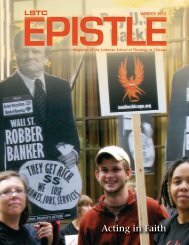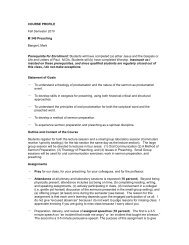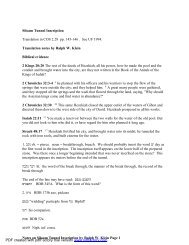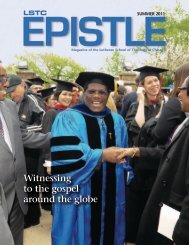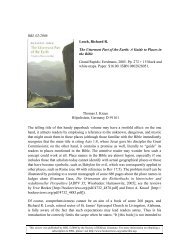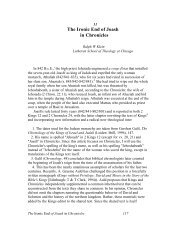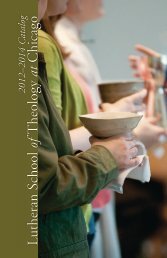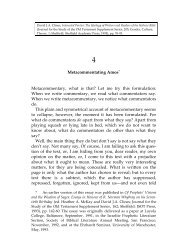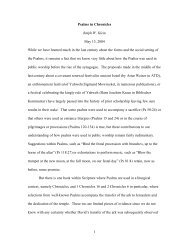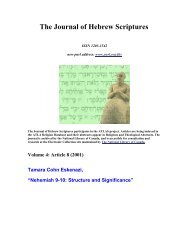18JOURNAL OF HEBREW SCRIPTURESTHE DEMISE OF JERUSALEM, THEDE-URBANIZATION OF JUDAH, AND THEASCENT OF BENJAMIN: REFLECTIONS ONODED LIPSCHITS’ THE FALL AND RISE OFJERUSALEMGARY N. KNOPPERS,PENNSYLVANIA STATE UNIVERSITYUNIVERSITY PARK, PA1. OVERVIEW AND GENERAL ASSESSMENTOne <strong>of</strong> the strengths <strong>of</strong> Lipschits’s recently published book is its ampleuse <strong>of</strong> archaeology, textual criticism, source criticism, redactioncriticism, historical geography, and Northwest Semitic epigraphy toshed new light on the Neo-Babylonian and early Persian periods inancient Judah. 6 Lipschits has performed a real service to the pr<strong>of</strong>essionby bringing together so much data, especially material evidence fromvarious archaeological excavations and site surveys, all <strong>of</strong> it bearing onthe study <strong>of</strong> a difficult and highly contested subject. His book is wellwritten,clearly-organized, and carefully-developed. Methodologically,his work pursues the intricate relationships between scripture andartifact, text and tell, written remains and material remains. In <strong>this</strong>respect, I think that it is helpful that Lipschits draws upon sources asdiverse as the LXX <strong>of</strong> Jeremiah, the mws@h seal impressions, the Zenonpapyri, and 1 Maccabees to engage the nature <strong>of</strong> life in Jerusalem,Judah, and Benjamin during the Neo-Babylonian and Persian periods.Given the nature <strong>of</strong> the written materials, both biblical and extrabiblical,the many gaps in our knowledge, and the many differentinterpretations <strong>of</strong> the archaeological data, <strong>this</strong> is a rather complicatedenterprise requiring considerable methodological sophistication.Lipschits is aware <strong>of</strong> these difficulties, but he does not let them get inthe way <strong>of</strong> pursuing his larger task <strong>of</strong> historical reconstruction. Indeed, Ithink that it is fair to say that even in many <strong>of</strong> those cases in which theevidence is still somewhat limited or ambiguous, Lipschits’s goal is topush the discussion forward by boldly proposing new theories to bridgethe gaps and clarify the ambiguities.6 This text is only slightly changed from the version <strong>of</strong> the talk I gave in thePersian Period History and Literature Section <strong>of</strong> the Society <strong>of</strong> BiblicalLiterature in November 2005. I have added a few sentences <strong>of</strong> clarification, aswell as a few footnotes for the convenience <strong>of</strong> readers.
“IN CONVERSATION WITH ODED LIPSCHITS” 19Some might contend after reading <strong>this</strong> book that Lipschits pressesthe evidence too far or is too optimistic in assessing our ability toascertain the precise function, date, and relevance <strong>of</strong> certain epigraphic,archaeological, and literary materials. Some may wonder whether thegrand attempt to marshal all <strong>of</strong> the available evidence into a clear andcomprehensive synthesis results in an overly-tidy reconstruction <strong>of</strong>Judaean demography and administration during <strong>this</strong> era. Whatever thecase, I am grateful for the bold attempt to shed new light on <strong>this</strong>neglected era in post-monarchic Judah. Better to push the discussionforward in a daring way than to repeat old canards about <strong>this</strong> epochbeing a virtual tabula rasa in the history <strong>of</strong> Judah.The sustained focus on the land <strong>of</strong> Judah and on Jerusalem, asopposed to shifting attention away from Judah to the diaspora(following the storyline <strong>of</strong> the historical books), is very helpful ingetting a grip on the continuities and discontinuities in the history <strong>of</strong> thesouthern Levant. Also quite useful are the specific comparisonsLipschits draws between the literary evidence pertaining to the borders<strong>of</strong> Judah during the late Iron Age and that pertaining to the borders <strong>of</strong>Judah during the Hellenistic Age, because these comparisons shed lighton the transformations that occur during the Achaemenid era. Finally,Lipschits’s command <strong>of</strong> the secondary literature pertaining to severalsub-fields is impressive.The writer's research needs to be seen against the background <strong>of</strong>two distinct trends in the study <strong>of</strong> the Neo-Babylonian period. Oneposition, represented recently by the work <strong>of</strong> Ephraim Stern, holds thatthe invasions <strong>of</strong> Nebuchadnezzar resulted in a very extensive, if notcomplete, population gap in the southern Levant during the Neo-Babylonian period. 7 Seen from <strong>this</strong> particular perspective, wholesections <strong>of</strong> the kingdom <strong>of</strong> Judah became a kind <strong>of</strong> wasteland in theaftermath <strong>of</strong> the Babylonian campaigns. Other scholars, most famouslyRobert Carroll and Hans Barstad, have reacted very strongly against thethesis typified in the work <strong>of</strong> Stern. As the titles <strong>of</strong> their works imply,"The Myth <strong>of</strong> the Empty Land" (by Carroll) and The Myth <strong>of</strong> the EmptyLand: A Study in the History and Archaeology <strong>of</strong> Judah during the "Exilic"Period (by Barstad), these scholars have argued for major continuity inthe occupation <strong>of</strong> the land in spite <strong>of</strong> the Babylonian victories againstthe Judaean kingdom. 8 Asserting that only a small elite was deportedfrom the land, these writers argue that life, for those who survived,went on pretty much as usual.In the context <strong>of</strong> <strong>this</strong> larger debate, the research <strong>of</strong> another scholarshould be mentioned, David Vanderho<strong>of</strong>t. In <strong>this</strong> substantial and wellarguedbook, The Neo-Babylonian Empire and Babylon in the Latter Prophets,7 Stern's views may be found in his Material Culture <strong>of</strong> the Land <strong>of</strong> the Bible inthe Persian Period 538-332 B.C. (Warminster: Aris and Phillips / Jerusalem: IsraelExploration Society, 1982). A recent defense and extension <strong>of</strong> his views may befound in his Archaeology <strong>of</strong> the Land <strong>of</strong> the Bible, vol. II: The Assyrian, Babylonian, andPersian Periods 732-332 BCE (ABRL; New York: Doubleday, 2001) 303-50.8 R. Carroll, “The Myth <strong>of</strong> the Empty Land,” Semeia 59 (1992) 79-93; H.Barstad, The Myth <strong>of</strong> the Empty Land: A Study in the History and Archaeology <strong>of</strong> JudahDuring the “Exilic” Period (Symbolae Osloenses, Fasc. Suppl. 28; Oslo:Scandinavian <strong>University</strong> Press, 1998).


